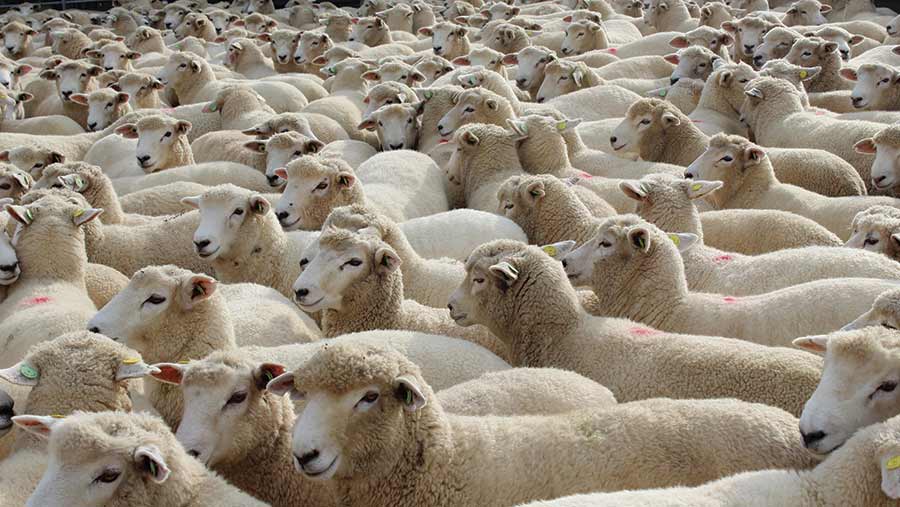How to get £75 a head gross margin with Romney ewes

New Zealand flock management principles and an unorthodox approach to breeding have been combined on a Scottish lowland farm with great success.
Marcus and Kate Maxwell’s Romney ewes are returning a sizeable gross margin of £75/head, with surplus female ewe lambs for 2016 already pre-sold. A large wool cheque also helps to boost income.
See also: New Zealand sheep farmer shares his secrets
A trip to New Zealand was the catalyst for change at Holm Farm, near Castle Douglas. Returning home to the family business in the late 1980s, Mr Maxwell set about importing some embryos and a small flock of the Romney sheep he had seen on his travels.
The Scottish Blackfaces, which had been used to produce Mules for crossing with a high-index Suffolk and then on to a Texel, were gradually phased out.
Today, the Maxwells run a 1,700-ewe Romney flock, as well as 250 suckler cows, with the help of one full-time shepherdess and a part-time worker on the farm, which covers 647ha, with a further 364ha of rented land.
Breeding
The couple’s Viewfield Romneys are not pedigree-registered, but are instead sub-divided into a stud flock and a commercial flock. Sheep may be transferred between the two, depending on performance, with the best rams used across all females.
EID is used as a tool to assess individual merit within the stud flock and as a substitute for the manual tag reading of the commercials.
The lambing percentage from the first Romney imports was 130% scanned, but the figure has since been increased to 190%, which maintains prolificacy without producing large numbers of pet lambs.
The ruthless selection policy applied over almost two decades means that issues with a negative effect on profitability, such as lambing problems and foot-rot, have all but been eliminated.
Neither foot-bathing nor foot-trimming is practised and faecal egg counting is used to determine anthelmintic policy.
“This intense selection pressure can only be applied to a closed flock, which is why we rely on our stockpile of imported New Zealand semen and never buy anything in,” explains Mr Maxwell.
“On average, we intervene in about half a dozen lambings a year. Ewes with foot-rot are culled; an animal which is treated one year will inevitably become lame the next, as well as passing on the infection.”
Production
A small quantity of concentrate feed is offered in the run-up to lambing, which starts on 10 April. Single male lambs are left entire and run as a separate group, with all finished lambs sold deadweight. Creep feed is used, on occasion.
“All our lambs are away by the end of October, before the entires become difficult to manage,” he says. “They finish faster than wethers; this year’s singles only took an average 100 days to slaughter. Liveweights were about 40kg, producing a carcass deadweight of 19.5kg and an R3L classification.
“If necessary, we will spend £2/head on creep, because it can reduce days to finishing by at least a couple of weeks and provide a grazing break. It can also improve conformation grading.”
Financials
The private sale of breeding animals is a significant source of income, and each year performance figures and photographs are published on the farm’s website.
Buyers pay a set price for each class, with rams, for example, costing £500 apiece, ewe lambs at £110 and draft ewes at £100. Some 670 ewe lambs went for breeding this year, along with 200 gimmer lambs, 200 draft ewes and about 70 females of mixed ages.
“Our prices have hardly changed over the past 15 years, because they are aligned with returns for finished lambs,” says Mr Maxwell. “The ram price is based on a typical scenario, in which he might cover 100 ewes, although in reality, ours will cover more.
“This would produce 150 lambs and he would last for an average of five seasons, which works out at just short of 70p a lamb.”
Romney fleeces are heavy – at an average 4.5kg apiece – and their wool is highly prized, invariably achieving top grades.
This combination produces an annual wool cheque of around £20,000. For the past five years, shearing has taken place biannually for the ewes, with the first session in June and the second at the end of August.
“The scanning results went up by 10% using biannual shearing and it also helps to maintain body condition. It keeps the sheep cool in the hot weather and allows their fleeces to dry out quickly when it is wet.
“Everyone is looking for sheep that are easy to manage. We have been in the fortunate position of being able to breed out many undesirable characteristics, which is probably why demand for our Romneys is steadily increasing,” says Mr Maxwell.

